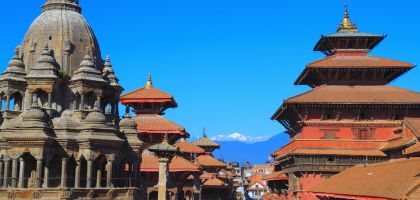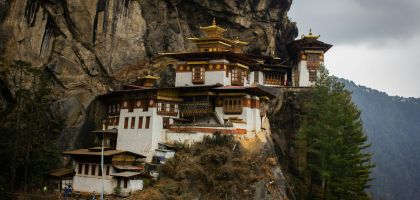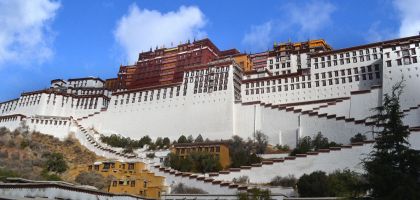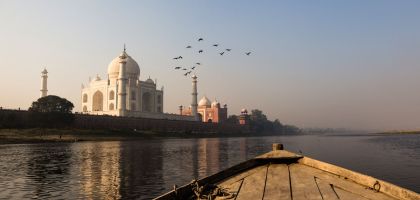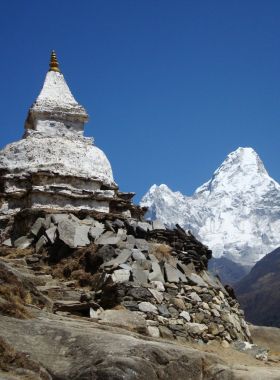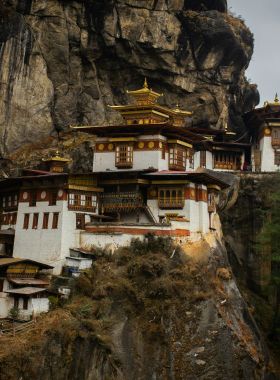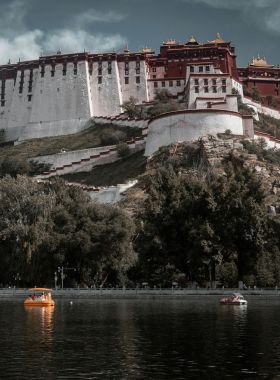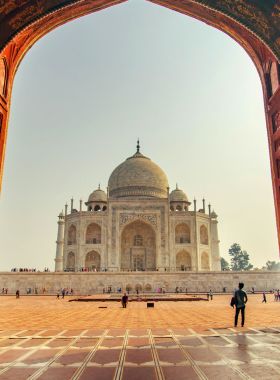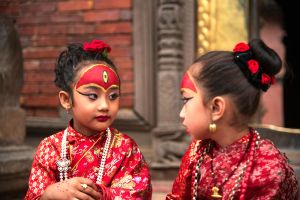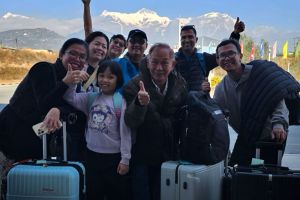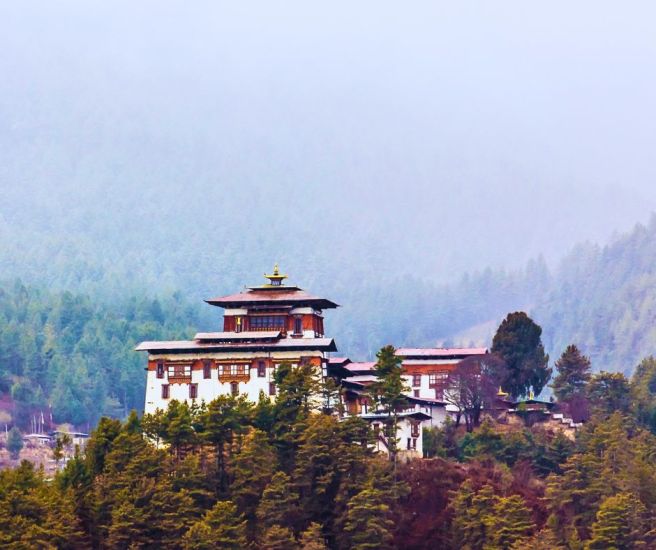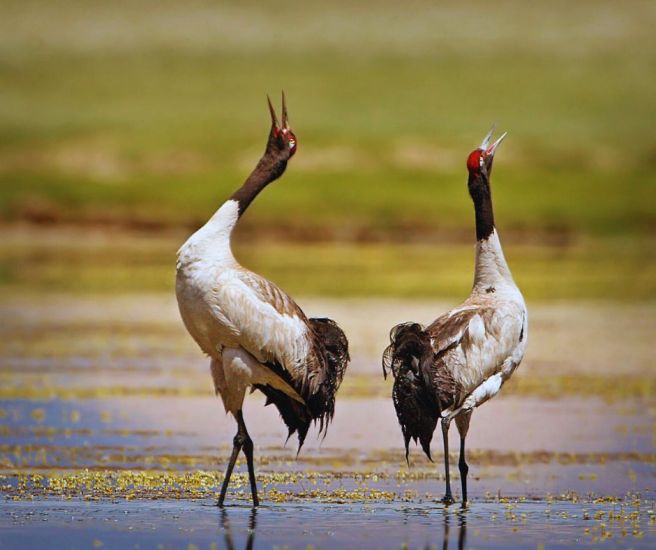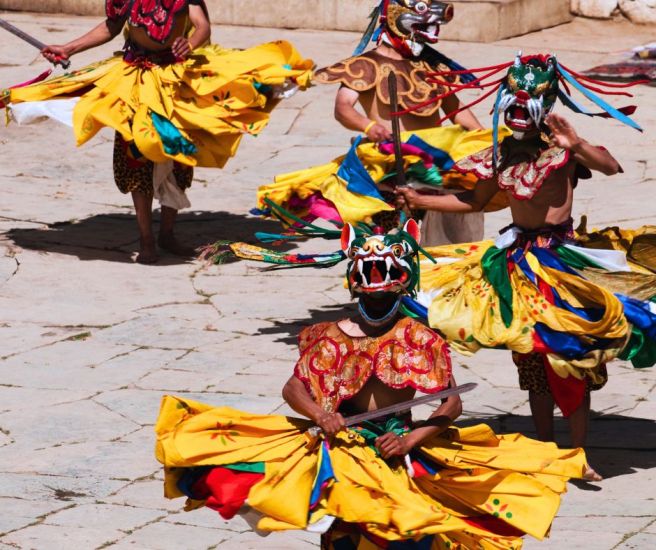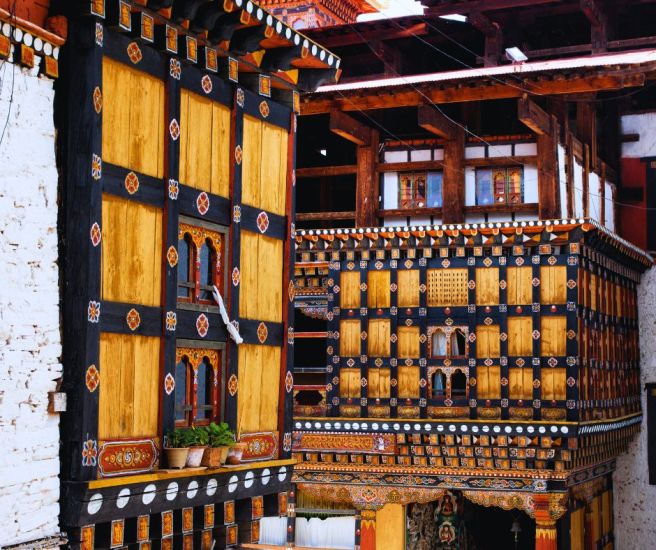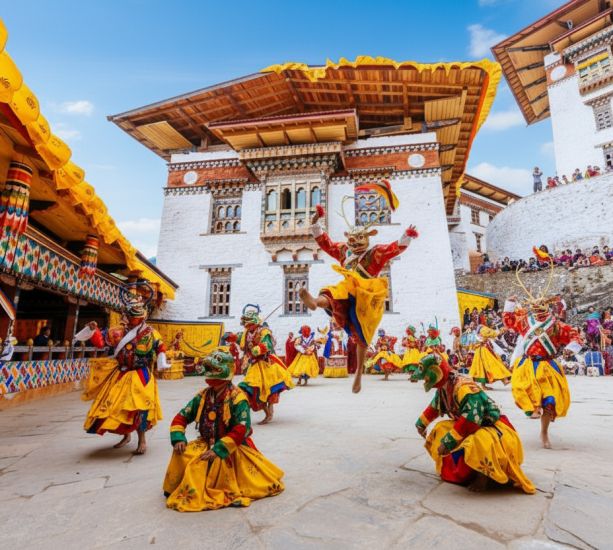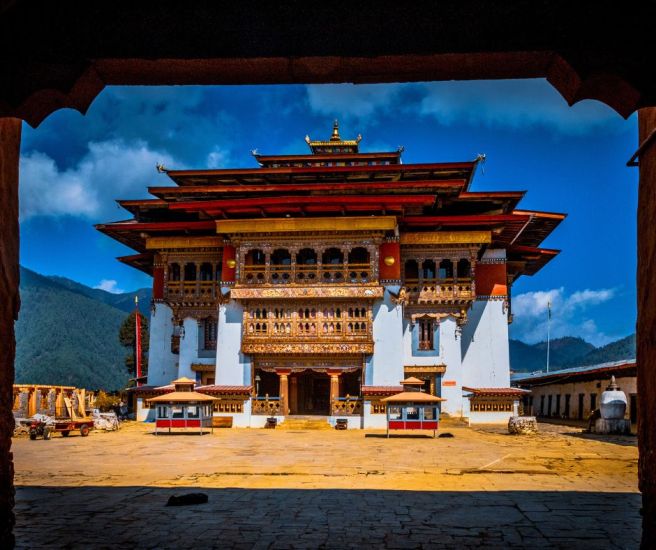Festival Tour in Bhutan – Gangtey Tshechu
12 Days / Bhutan
Activity
Difficulty Level
Destinations
Trip Start / End
Accommodation
Travel Style
Best time to travel
Personalized Travel Advice

Dev Raj Nepal
+977 9851096523
Personalized Travel Advice

Dev Raj Nepal
+977 9851096523
Detailed Itinerary
01
DAY
01
Your journey begins as you touch down at Paro International Airport, where the crisp mountain air and panoramic views of the Himalayas welcome you to Bhutan.
On the way to Thimphu, stop at Tachogang Lhakhang Bridge, a 15th-century iron suspension bridge adorned with colorful prayer flags. Built by the famous Nyingma tantric master Tangtong Gyalpo, it offers a unique glimpse into Bhutanese history and traditional bridge construction.
Continue the scenic drive to Thimphu, Bhutan’s charming capital, where tradition meets modernity. Once in Thimphu, visit Tashichho Dzong, a beautiful fortress-monastery that serves as the administrative and religious center of Bhutan. After your sightseeing, check in to your hotel for a restful night. Spend the night at a hotel in Thimphu as the day marks the beginning of your magical festival tour in Bhutan.
Arrival in Paro – Transfer to Thimphu
Your journey begins as you touch down at Paro International Airport, where the crisp mountain air and panoramic views of the Himalayas welcome you to Bhutan.
On the way to Thimphu, stop at Tachogang Lhakhang Bridge, a 15th-century iron suspension bridge adorned with colorful prayer flags. Built by the famous Nyingma tantric master Tangtong Gyalpo, it offers a unique glimpse into Bhutanese history and traditional bridge construction.
Continue the scenic drive to Thimphu, Bhutan’s charming capital, where tradition meets modernity. Once in Thimphu, visit Tashichho Dzong, a beautiful fortress-monastery that serves as the administrative and religious center of Bhutan. After your sightseeing, check in to your hotel for a restful night. Spend the night at a hotel in Thimphu as the day marks the beginning of your magical festival tour in Bhutan.
02
DAY
02
Our sightseeing in Thimphu begins with a visit to Buddha Dordenma, an enormous golden statue seated atop a hill overlooking the valley. Standing at 51 meters, this majestic statue is one of the largest Buddha statues in the world and houses thousands of smaller Buddha statues inside. The site offers panoramic views of Thimphu, making it a perfect start to the day.
Next, we visit the Memorial Chorten, a sacred stupa built in honor of Bhutan’s third king, Jigme Dorji Wangchuck. Locals circumambulate the chorten, spinning prayer wheels and offering prayers, creating a deeply spiritual atmosphere. Afterward, we proceed to the National Institute for Zorig Chusum, commonly known as the School of Traditional Arts, where students meticulously practice Bhutan’s 13 traditional arts, including painting, wood carving, and embroidery. This visit provides valuable insight into Bhutan’s dedication to preserving its artistic heritage.
From there, we explore the Folk Heritage Museum, housed in a traditional Bhutanese farmhouse. This living museum offers an immersive experience into rural Bhutanese life, displaying household artifacts, farming tools, and an authentic setting that showcases how Bhutanese families have lived for centuries.
To conclude our day, we visit Changangkha Lhakhang, one of the oldest temples in Thimphu, perched on a ridge overlooking the city. This temple is a spiritual haven for Bhutanese parents who bring their newborns for blessings, and it offers stunning views of the valley below. For travelers planning a festival tour in Bhutan, the vibrant cultural spirit felt here in Thimphu sets the stage for experiencing the country’s most colorful celebrations.
Thimphu Exploration
Our sightseeing in Thimphu begins with a visit to Buddha Dordenma, an enormous golden statue seated atop a hill overlooking the valley. Standing at 51 meters, this majestic statue is one of the largest Buddha statues in the world and houses thousands of smaller Buddha statues inside. The site offers panoramic views of Thimphu, making it a perfect start to the day.
Next, we visit the Memorial Chorten, a sacred stupa built in honor of Bhutan’s third king, Jigme Dorji Wangchuck. Locals circumambulate the chorten, spinning prayer wheels and offering prayers, creating a deeply spiritual atmosphere. Afterward, we proceed to the National Institute for Zorig Chusum, commonly known as the School of Traditional Arts, where students meticulously practice Bhutan’s 13 traditional arts, including painting, wood carving, and embroidery. This visit provides valuable insight into Bhutan’s dedication to preserving its artistic heritage.
From there, we explore the Folk Heritage Museum, housed in a traditional Bhutanese farmhouse. This living museum offers an immersive experience into rural Bhutanese life, displaying household artifacts, farming tools, and an authentic setting that showcases how Bhutanese families have lived for centuries.
To conclude our day, we visit Changangkha Lhakhang, one of the oldest temples in Thimphu, perched on a ridge overlooking the city. This temple is a spiritual haven for Bhutanese parents who bring their newborns for blessings, and it offers stunning views of the valley below. For travelers planning a festival tour in Bhutan, the vibrant cultural spirit felt here in Thimphu sets the stage for experiencing the country’s most colorful celebrations.
03
DAY
03
We will begin our day by exploring the Bhutan Postal Museum. This museum showcases Bhutan’s unique postal history and its famous personalized stamps. You can even get their own photo printed on a Bhutanese stamp as a souvenir. We will then drive towards Punakha.
Our route will take us over the Dochula Pass, situated at 3,100 meters (10,200 feet). At this pass, we’ll stop to enjoy panoramic views of the snow-capped Himalayas and the surrounding valleys, provided the weather is clear.
The journey takes us through charming villages and terraced fields, offering glimpses into rural Bhutanese life. We will also visit the Royal Botanical Park at Lamperi, known for its rich collection of flora and beautiful landscape. Overnight at Punakha.
Thimphu – Punakha
We will begin our day by exploring the Bhutan Postal Museum. This museum showcases Bhutan’s unique postal history and its famous personalized stamps. You can even get their own photo printed on a Bhutanese stamp as a souvenir. We will then drive towards Punakha.
Our route will take us over the Dochula Pass, situated at 3,100 meters (10,200 feet). At this pass, we’ll stop to enjoy panoramic views of the snow-capped Himalayas and the surrounding valleys, provided the weather is clear.
The journey takes us through charming villages and terraced fields, offering glimpses into rural Bhutanese life. We will also visit the Royal Botanical Park at Lamperi, known for its rich collection of flora and beautiful landscape. Overnight at Punakha.
04
DAY
04
Today, we immerse ourselves in the enchanting sights and cultural heritage of Punakha. After breakfast, we set out to explore the historical and natural wonders of this picturesque region. Our first stop will be the Punakha Dzong, an architectural masterpiece located at the confluence of the Pho Chhu and Mo Chhu rivers. Built in 1637 by Zhabdrung Ngawang Namgyal, this impressive fortress served as Bhutan’s winter capital and remains an important administrative and religious center. The dzong is renowned for its stunning design, grand courtyards, intricate woodwork, and sacred temples, making it one of Bhutan’s most magnificent structures.
Following our visit to the dzong, we’ll take a short scenic walk through the countryside to Chimi Lhakhang, also known as the Fertility Temple. This revered site, built in 1499, is dedicated to the Buddhist saint Drukpa Kunley, known as the “Divine Madman” for his unconventional ways of teaching. The temple is believed to bless couples with fertility, attracting pilgrims from across Bhutan and beyond.
In the afternoon, we take a short 1-hour hike to Khamsum Yulley Namgyal Chorten, a magnificent hilltop monastery built to bring peace and prosperity to Bhutan. The gentle uphill hike winds through rice fields and pine forests, rewarding us with panoramic views of the Punakha Valley from the top. The chorten itself is a remarkable example of Bhutanese architecture and spiritual artistry, making it a perfect conclusion to our day’s exploration.
Punakha Exploration
Today, we immerse ourselves in the enchanting sights and cultural heritage of Punakha. After breakfast, we set out to explore the historical and natural wonders of this picturesque region. Our first stop will be the Punakha Dzong, an architectural masterpiece located at the confluence of the Pho Chhu and Mo Chhu rivers. Built in 1637 by Zhabdrung Ngawang Namgyal, this impressive fortress served as Bhutan’s winter capital and remains an important administrative and religious center. The dzong is renowned for its stunning design, grand courtyards, intricate woodwork, and sacred temples, making it one of Bhutan’s most magnificent structures.
Following our visit to the dzong, we’ll take a short scenic walk through the countryside to Chimi Lhakhang, also known as the Fertility Temple. This revered site, built in 1499, is dedicated to the Buddhist saint Drukpa Kunley, known as the “Divine Madman” for his unconventional ways of teaching. The temple is believed to bless couples with fertility, attracting pilgrims from across Bhutan and beyond.
In the afternoon, we take a short 1-hour hike to Khamsum Yulley Namgyal Chorten, a magnificent hilltop monastery built to bring peace and prosperity to Bhutan. The gentle uphill hike winds through rice fields and pine forests, rewarding us with panoramic views of the Punakha Valley from the top. The chorten itself is a remarkable example of Bhutanese architecture and spiritual artistry, making it a perfect conclusion to our day’s exploration.
05
DAY
05
After an early breakfast, we set off for the scenic Phobjikha Valley, a 2.5 hour drive. En route, we cross the Lawala Pass, before descending into the glacial Phobjikha Valley, nestled on the slopes of the Black Mountains. Known also as Gangtey, Phobjikha is famous for its serene landscapes and as a winter home for the endangered black-necked cranes.
Upon arrival, we visit Gangtey Monastery, a key spiritual site in the region, offering panoramic views of the valley and a deeper understanding of Bhutanese Buddhism. This is also the venue for Gangtey Tshechu, the spot where we witness this fascinating festival.
Afterward, we embark on the Gangtey Nature Trail, a scenic 45-minute walk through forests and meadows, with the opportunity to observe local wildlife and enjoy the peaceful surroundings. This easy walk offers magnificent views of the valley and is a perfect way to explore the natural beauty of the area. We return to our hotel in the evening and prepare for our pivotal moment in our festival tour of Bhutan the next day.
Punakha – Phobjikha
After an early breakfast, we set off for the scenic Phobjikha Valley, a 2.5 hour drive. En route, we cross the Lawala Pass, before descending into the glacial Phobjikha Valley, nestled on the slopes of the Black Mountains. Known also as Gangtey, Phobjikha is famous for its serene landscapes and as a winter home for the endangered black-necked cranes.
Upon arrival, we visit Gangtey Monastery, a key spiritual site in the region, offering panoramic views of the valley and a deeper understanding of Bhutanese Buddhism. This is also the venue for Gangtey Tshechu, the spot where we witness this fascinating festival.
Afterward, we embark on the Gangtey Nature Trail, a scenic 45-minute walk through forests and meadows, with the opportunity to observe local wildlife and enjoy the peaceful surroundings. This easy walk offers magnificent views of the valley and is a perfect way to explore the natural beauty of the area. We return to our hotel in the evening and prepare for our pivotal moment in our festival tour of Bhutan the next day.
06
DAY
06
Today, we fully immerse ourselves in the beauty and culture of Phobjikha. After breakfast, we begin with a village walk, exploring the rural life of the local people, learning about traditional farming practices, and experiencing the charm of Bhutanese villages. During the walk, you’ll gain insight into how the local community coexists with nature and agriculture, offering a deep connection to the land.
The highlight of the day is attending the Gangtey Tsechu, an unmissable opportunity to witness one of Bhutan’s most vibrant cultural celebrations. Held annually at Gangtey Monastery in the Phobjikha Valley, typically in November or December, this traditional religious festival showcases sacred Cham dances performed by monks in colorful costumes and masks. Each dance represents an aspect of Bhutanese Buddhist teachings, offering a mesmerizing glimpse into the spiritual and cultural heritage of the region.
This experience provides an authentic look at Bhutanese traditions, making it a perfect addition for travelers interested in a festival tour in Bhutan.
Phobjikha Exploration
Today, we fully immerse ourselves in the beauty and culture of Phobjikha. After breakfast, we begin with a village walk, exploring the rural life of the local people, learning about traditional farming practices, and experiencing the charm of Bhutanese villages. During the walk, you’ll gain insight into how the local community coexists with nature and agriculture, offering a deep connection to the land.
The highlight of the day is attending the Gangtey Tsechu, an unmissable opportunity to witness one of Bhutan’s most vibrant cultural celebrations. Held annually at Gangtey Monastery in the Phobjikha Valley, typically in November or December, this traditional religious festival showcases sacred Cham dances performed by monks in colorful costumes and masks. Each dance represents an aspect of Bhutanese Buddhist teachings, offering a mesmerizing glimpse into the spiritual and cultural heritage of the region.
This experience provides an authentic look at Bhutanese traditions, making it a perfect addition for travelers interested in a festival tour in Bhutan.
07
DAY
07
Today, we take a scenic drive towards Bumthang, one of the most beautiful and culturally rich regions in Bhutan. The journey is filled with stunning landscapes and historical sights. Our first stop along the way is the Chendebji Chorten, a prominent stupa built in the 18th century, located near the village of Chendebji. This serene spot is a perfect place to stretch your legs while taking in the peaceful surroundings.
Continuing our drive, we’ll pass through the picturesque village of Trongsa and its impressive Trongsa Dzong, perched dramatically on a ridge above the town. A visit to the Royal Heritage Museum in Trongsa provides fascinating insights into Bhutan’s royal history, offering an educational break during our drive.
Lunch will be served at the tranquil Willing Falls, a delightful spot perfect for a relaxing break amidst the journey. After lunch, we continue our drive towards Bumthang, arriving in the evening. We arrive at our hotel in Bumthang, where you can unwind and prepare for another day of exploring the region.
Optional Hot Stone Bath: You can experience a traditional Hot Stone Bath with advance notice. Hot stone bath is purely a Bhutanese traditional method of curing skin ailments, joint pains, hypertension, stomach disorders, arthritis, and many other minor diseases. Even if you don’t have any of these issues, after a laborious hike of the day, you will feel relaxation from the hot stone bath. Pre-booking is a requirement.
Gangtey – Bumthang
Today, we take a scenic drive towards Bumthang, one of the most beautiful and culturally rich regions in Bhutan. The journey is filled with stunning landscapes and historical sights. Our first stop along the way is the Chendebji Chorten, a prominent stupa built in the 18th century, located near the village of Chendebji. This serene spot is a perfect place to stretch your legs while taking in the peaceful surroundings.
Continuing our drive, we’ll pass through the picturesque village of Trongsa and its impressive Trongsa Dzong, perched dramatically on a ridge above the town. A visit to the Royal Heritage Museum in Trongsa provides fascinating insights into Bhutan’s royal history, offering an educational break during our drive.
Lunch will be served at the tranquil Willing Falls, a delightful spot perfect for a relaxing break amidst the journey. After lunch, we continue our drive towards Bumthang, arriving in the evening. We arrive at our hotel in Bumthang, where you can unwind and prepare for another day of exploring the region.
Optional Hot Stone Bath: You can experience a traditional Hot Stone Bath with advance notice. Hot stone bath is purely a Bhutanese traditional method of curing skin ailments, joint pains, hypertension, stomach disorders, arthritis, and many other minor diseases. Even if you don’t have any of these issues, after a laborious hike of the day, you will feel relaxation from the hot stone bath. Pre-booking is a requirement.
08
DAY
08
A walking tour of Bumthang’s villages and heritage sites is absolutely important. We begin with a visit to the region’s most revered temples: Jambay Lhakhang, Kurjey Lhakhang, and Tamshing Lhakhang. These temples are rich in history and spirituality, offering insight into Bhutanese Buddhist traditions. Jambay Lhakhang, built in the 7th century by the Tibetan King Songtsen Gampo, is an iconic pilgrimage site. Kurjey Lhakhang, with its beautiful architecture, houses the rock imprint of Guru Rinpoche, who meditated here. Tamshing Lhakhang, founded by the famous Lama Pema Lingpa, is an important center for spiritual learning and known for its sacred murals. The walk between these temples takes you through beautiful landscapes, offering a chance to enjoy the peaceful surroundings of Bumthang.
After the temple visits, we head to a traditional farmhouse where we will participate in a cooking class to prepare Ema Datshi, Bhutan’s beloved dish made with chilies and cheese. It’s a wonderful hands-on experience where you’ll learn about Bhutanese ingredients and culinary traditions. Lunch will be served with the fruits of your labor, allowing you to enjoy the delicious flavors of Bhutanese cuisine.
In the afternoon, we’ll visit the Dorjibi Weaving Centre, where you can witness the intricate art of traditional Bhutanese weaving. The center is famous for producing beautiful textiles, including handwoven fabrics and garments, showcasing the skilled craftsmanship of the locals. It’s an excellent opportunity to learn about the significance of weaving in Bhutanese culture and purchase some unique souvenirs.
Bumthang Exploration
A walking tour of Bumthang’s villages and heritage sites is absolutely important. We begin with a visit to the region’s most revered temples: Jambay Lhakhang, Kurjey Lhakhang, and Tamshing Lhakhang. These temples are rich in history and spirituality, offering insight into Bhutanese Buddhist traditions. Jambay Lhakhang, built in the 7th century by the Tibetan King Songtsen Gampo, is an iconic pilgrimage site. Kurjey Lhakhang, with its beautiful architecture, houses the rock imprint of Guru Rinpoche, who meditated here. Tamshing Lhakhang, founded by the famous Lama Pema Lingpa, is an important center for spiritual learning and known for its sacred murals. The walk between these temples takes you through beautiful landscapes, offering a chance to enjoy the peaceful surroundings of Bumthang.
After the temple visits, we head to a traditional farmhouse where we will participate in a cooking class to prepare Ema Datshi, Bhutan’s beloved dish made with chilies and cheese. It’s a wonderful hands-on experience where you’ll learn about Bhutanese ingredients and culinary traditions. Lunch will be served with the fruits of your labor, allowing you to enjoy the delicious flavors of Bhutanese cuisine.
In the afternoon, we’ll visit the Dorjibi Weaving Centre, where you can witness the intricate art of traditional Bhutanese weaving. The center is famous for producing beautiful textiles, including handwoven fabrics and garments, showcasing the skilled craftsmanship of the locals. It’s an excellent opportunity to learn about the significance of weaving in Bhutanese culture and purchase some unique souvenirs.
09
DAY
09
After an early breakfast, we embark on an exciting excursion to the scenic Tang Valley, one of the most beautiful valleys in Bhutan. As we drive through the valley, the stunning landscapes unfold around us, offering views of terraced fields, traditional farmhouses, and the surrounding mountains.
Our first stop is the Burning Lake (also known as Me Bar Tsho), one of the most sacred sites in Bhutan. It is said that in the 14th century, Guru Rinpoche’s disciple, Pema Lingpa, discovered a hidden treasure in the lake, and the site has since become a pilgrimage spot for Bhutanese Buddhists. The lake’s serene beauty, combined with its spiritual significance, creates a profoundly peaceful atmosphere.
Next, we visit the Pema Choling Nunnery, an important center for nuns in the region. This peaceful nunnery provides insight into the monastic life and the role of women in Bhutanese spirituality. Here, you can interact with the nuns and learn about their daily routines, meditation practices, and the teachings they follow.
Afterward, we explore the Ogyen Cholling Palace Museum, which was once the ancestral home of the Chhoetje family, a prominent family in the region. The museum offers a fascinating glimpse into the history of the family and the cultural heritage of the Tang Valley. The exhibits include traditional artifacts, clothing, and items used in the past, reflecting Bhutan’s rich cultural traditions.
For lunch, we’ll enjoy a special meal at Ogyen Cholling, prepared by the estate’s organic gardener. The lunch will feature fresh, locally sourced ingredients, offering a delightful taste of Bhutanese farm-to-table cuisine. Afterward, we’ll have some time to relax and explore the surroundings before returning to Bumthang for the night.
Bumthang (Excursion to Tang Valley)
After an early breakfast, we embark on an exciting excursion to the scenic Tang Valley, one of the most beautiful valleys in Bhutan. As we drive through the valley, the stunning landscapes unfold around us, offering views of terraced fields, traditional farmhouses, and the surrounding mountains.
Our first stop is the Burning Lake (also known as Me Bar Tsho), one of the most sacred sites in Bhutan. It is said that in the 14th century, Guru Rinpoche’s disciple, Pema Lingpa, discovered a hidden treasure in the lake, and the site has since become a pilgrimage spot for Bhutanese Buddhists. The lake’s serene beauty, combined with its spiritual significance, creates a profoundly peaceful atmosphere.
Next, we visit the Pema Choling Nunnery, an important center for nuns in the region. This peaceful nunnery provides insight into the monastic life and the role of women in Bhutanese spirituality. Here, you can interact with the nuns and learn about their daily routines, meditation practices, and the teachings they follow.
Afterward, we explore the Ogyen Cholling Palace Museum, which was once the ancestral home of the Chhoetje family, a prominent family in the region. The museum offers a fascinating glimpse into the history of the family and the cultural heritage of the Tang Valley. The exhibits include traditional artifacts, clothing, and items used in the past, reflecting Bhutan’s rich cultural traditions.
For lunch, we’ll enjoy a special meal at Ogyen Cholling, prepared by the estate’s organic gardener. The lunch will feature fresh, locally sourced ingredients, offering a delightful taste of Bhutanese farm-to-table cuisine. Afterward, we’ll have some time to relax and explore the surroundings before returning to Bumthang for the night.
10
DAY
10
We will take a short drive to Jakar to catch a flight from Bumthang to Paro, Bhutan’s beautiful and historic town, known for its picturesque landscapes and important cultural sites. Upon arrival, we’ll begin exploring this enchanting destination.
Our first visit will be to the National Museum of Bhutan, housed in the historic Ta Dzong, an ancient watchtower that dates back to 1656. The museum, converted into its present form in 1968, offers an extensive collection of Bhutanese art, including rare bronze statues, paintings, and religious artifacts, all reflecting Bhutan’s rich cultural and spiritual heritage. The museum’s exhibits give a fascinating insight into Bhutanese history, culture, and traditions, making it a must-see for any visitor.
Next, we’ll head to Rinpung Dzong, one of Bhutan’s most iconic landmarks. This stunning fortress-monastery, built in 1646, is perched on a hilltop overlooking the Paro Chu River. Known for its grand architecture and historical significance, Rinpung Dzong serves as the administrative center of the Paro district. We will take time to explore the dzong’s beautiful courtyards, temples, and murals, all of which are intricately decorated with traditional Bhutanese art. This site also holds religious significance and offers panoramic views of the valley below.
Bumthang to Paro (Flight)
We will take a short drive to Jakar to catch a flight from Bumthang to Paro, Bhutan’s beautiful and historic town, known for its picturesque landscapes and important cultural sites. Upon arrival, we’ll begin exploring this enchanting destination.
Our first visit will be to the National Museum of Bhutan, housed in the historic Ta Dzong, an ancient watchtower that dates back to 1656. The museum, converted into its present form in 1968, offers an extensive collection of Bhutanese art, including rare bronze statues, paintings, and religious artifacts, all reflecting Bhutan’s rich cultural and spiritual heritage. The museum’s exhibits give a fascinating insight into Bhutanese history, culture, and traditions, making it a must-see for any visitor.
Next, we’ll head to Rinpung Dzong, one of Bhutan’s most iconic landmarks. This stunning fortress-monastery, built in 1646, is perched on a hilltop overlooking the Paro Chu River. Known for its grand architecture and historical significance, Rinpung Dzong serves as the administrative center of the Paro district. We will take time to explore the dzong’s beautiful courtyards, temples, and murals, all of which are intricately decorated with traditional Bhutanese art. This site also holds religious significance and offers panoramic views of the valley below.
11
DAY
11
Drive to Satsam Chorten for a soft hike to Taktsang Monastery. The name Taktsang means “Tiger’s Nest”. The monastery is perched on a rocky ledge with a sheer drop of nearly 800m, overlooking the Paro Valley and the river. It is said that in the second half of the 8th century, Guru Padma Sambhava known as the second Buddha in Bhutan, meditated at the spot where the monastery is situated having alighted there on the back of a flying tigress.
The hike takes about 4 hours back and forth. Once you reach the view point of the monastery you have the option to visit the monastery which takes another hour hike.
In the afternoon, we will add a fun, cultural activity by stopping at a local archery range to try your hand at Bhutan’s national sport. Archery is not only a recreational pastime but also an important part of Bhutanese culture and tradition.
After the archery session, we will visit Kyichu Lhakhang, one of Bhutan’s oldest and most revered temples, built in the 7th century. To wrap up the day, we’ll head to a local farmhouse for a cozy dinner with a Bhutanese family, offering you a taste of authentic Bhutanese cuisine and the warmth of local hospitality.
Paro – Hike to Tiger’s Nest
Drive to Satsam Chorten for a soft hike to Taktsang Monastery. The name Taktsang means “Tiger’s Nest”. The monastery is perched on a rocky ledge with a sheer drop of nearly 800m, overlooking the Paro Valley and the river. It is said that in the second half of the 8th century, Guru Padma Sambhava known as the second Buddha in Bhutan, meditated at the spot where the monastery is situated having alighted there on the back of a flying tigress.
The hike takes about 4 hours back and forth. Once you reach the view point of the monastery you have the option to visit the monastery which takes another hour hike.
In the afternoon, we will add a fun, cultural activity by stopping at a local archery range to try your hand at Bhutan’s national sport. Archery is not only a recreational pastime but also an important part of Bhutanese culture and tradition.
After the archery session, we will visit Kyichu Lhakhang, one of Bhutan’s oldest and most revered temples, built in the 7th century. To wrap up the day, we’ll head to a local farmhouse for a cozy dinner with a Bhutanese family, offering you a taste of authentic Bhutanese cuisine and the warmth of local hospitality.
12
DAY
12
After a final breakfast in Bhutan, we escort you to Paro International Airport, wrapping up your Bhutan cultural tour filled with serene monasteries, vibrant festivals, and cherished encounters with Bhutanese traditions.
Paro – Departure
After a final breakfast in Bhutan, we escort you to Paro International Airport, wrapping up your Bhutan cultural tour filled with serene monasteries, vibrant festivals, and cherished encounters with Bhutanese traditions.
Tour Cost
At High Asia Tours, we know that understanding tour costs is essential for planning your trip. Due to variables such as accommodation choices, meal plans, transportation options, group size, and seasonal demand, providing an exact price upfront is challenging.
To assist you, we offer a starting price to give a general idea of the cost:
The starting cost for this tour is
Includes / Excludes
Inclusions
-
Accommodation on twin sharing.
-
All transfers and sightseeing as on itinerary.
-
Three meals a day.
-
English speaking local Tour Guide.
-
Sightseeing admission fee.
-
Bhutan visa fee.
Exclusions
-
Airfare to and out of Bhutan.
-
Expenses of personal nature such as drinks, tip, laundry, phone etc.
-
Extra expenses due to nature and unforeseen events.
-
Travel Insurance.
Trip Info
Festival Tour in Bhutan
Embarking on a festival tour in Bhutan opens a doorway into the kingdom’s vibrant spiritual and cultural soul. Tours like these, unfold the magic of Bhutan’s sacred Tshechus, majestic gatherings at monasteries and dzongs where devotion, artistry, and ritual converge. Time-honored traditions awaken, revealing the rhythms, colors, and stories that have shaped Bhutan for centuries. Every festival is a living tapestry where ceremonial dances, sacred chants, and communal reverence intertwine seamlessly with the serene beauty of the Himalayas.
At the heart of these festivals lie the cham dances performed with meticulous precision by monks and villagers in elaborately adorned masks and costumes. Each step, gesture, and spin conveys the legends of saints, deities, and moral teachings, weaving a narrative that is visually mesmerizing and spiritually profound. The valleys resonate with the deep tones of traditional instruments, punctuated by drums and chants that ripple through the crisp mountain air. Crowds gather in resplendent traditional attire, their quiet awe amplifying the sacred energy that hums throughout the gathering.
Beyond spectacle, festival tours in Bhutan offer an intimate encounter with the kingdom’s living spirituality. Travelers witness the unfurling of enormous thongdrols, partake in blessings, and absorb rituals that have endured for generations. From Thimphu’s lively squares to the hushed grandeur of Gangtey Valley, each festival becomes a journey of discovery, a communion with Bhutan’s heritage, and an invitation to feel the pulse of a culture that unites devotion, artistry, and the natural world. Participating in these tours is more than travel. It is immersion in a living tradition where every sight, sound, and gesture resonates with the spirit of Bhutan.
The Gangtey Tshechu is a vibrant and revered religious festival held annually at Gangtey Monastery in the Phobjikha Valley of central Bhutan. Dedicated to Guru Rinpoche, the 8th-century saint who introduced Buddhism to Bhutan, the festival is a celebration of Bhutanese spiritual heritage. The term “Tshechu” means “tenth day,” indicating that the festival is held on the tenth day of the lunar month according to the Bhutanese calendar, on dates considered highly auspicious.
The origins of the Gangtey Tshechu date back several centuries and are closely tied to the founding of Gangtey Monastery in 1613. Over time, it has become a central cultural and spiritual event for the local communities in the Phobjikha Valley. The festival’s timing in October coincides with the arrival of the black-necked cranes, adding a unique ecological dimension to this cultural celebration.
During the festival, the monastery and the valley come alive with sacred mask dances called “cham,” performed by monks and local participants. These dances depict Buddhist teachings, illustrating the triumph of good over evil and the purification of negative karma. A highlight of the festival is the unfurling of a giant thangka of Guru Rinpoche, believed to bestow blessings on all who witness it. The Gangtey Tshechu offers a rare opportunity to witness Bhutanese traditions, spirituality, and community life in full expression, making it an unforgettable cultural experience.
The Gangtey Festival (Gangtey Tshechu) 2026 is scheduled from September 24 to September 26 and will be held at the historic Gangtey Gonpa in Wangduephodrang. This vibrant festival showcases traditional Bhutanese rituals, mask dances, and cultural performances, offering a unique glimpse into the spiritual and cultural heritage of the region.
The 3- day festival culminates with the Thongdral unfurling ceremony on the final day, a sacred event that draws both locals and visitors to witness the giant ceremonial thangka being displayed, creating a memorable and deeply spiritual experience.
From September to October, Bhutan enjoys clear skies as the monsoon season ends, offering stunning views of the Himalayas. Daytime temperatures in lower-altitude regions such as Paro, Thimphu, and Punakha typically range from 15°C to 22°C (59°F to 72°F). Phobjikha Valley, where the festival takes place, is cooler, with daytime highs around 12°C to 18°C (54°F to 64°F) and nighttime lows dropping to 4°C to 6°C (39°F to 43°F). Higher-altitude areas are even cooler, with daytime highs around 10°C to 15°C (50°F to 59°F) and nighttime lows of 5°C to 8°C (41°F to 46°F).
The weather remains generally dry, making it ideal for sightseeing, trekking, and festival experiences. Visitors are advised to pack light jackets or sweaters for the day and warmer layers for cool evenings and excursions to higher altitudes. Recent forecasts for late September 2025 indicate partly sunny days with occasional afternoon showers, reflecting stable post-monsoon conditions.
During your tour of Bhutan, you will be staying in carefully selected accommodations that blend comfort, cultural authenticity, and serene beauty, offering you the perfect retreat amidst the majestic Himalayan landscapes. We’ve chosen each hotel and lodge for its ability to offer a unique cultural experience, while ensuring that you have the modern conveniences necessary for a restful stay. Whether you’re in bustling Thimphu or the peaceful Paro Valley, your accommodation will serve as an inviting home base, offering both a sense of tranquility and an opportunity to immerse yourself in Bhutanese culture.
These properties are designed with traditional Bhutanese architecture, using locally sourced materials such as wood and stone, which create a natural harmony with the stunning surroundings. The interiors often feature Bhutanese artwork, handcrafted furniture, and warm colors that bring the rich cultural heritage of Bhutan into the very heart of the accommodation. Each room is thoughtfully furnished with comfort in mind, ensuring a restful experience after a day of exploration. You’ll find all the necessary amenities—such as comfortable bedding, modern bathrooms, and heating—while still experiencing the rustic charm that makes Bhutan so special.
Bhutanese cuisine, widely available in both restaurants and hotels, centers around rice as a staple, accompanied by an assortment of flavorful side dishes. These typically include lentils, a variety of meats, and fresh vegetables, all prepared with unique Bhutanese spices that enhance their taste. Whether you prefer vegetarian meals or enjoy non-vegetarian dishes, Bhutan offers a diverse culinary experience to suit every palate.
For those looking to explore beyond the standard offerings, rural regions introduce a distinct aspect of Bhutanese food culture. Here, people commonly consume red rice and buckwheat-based dishes, adding a rustic and wholesome dimension to the dining experience. Trying these traditional staples not only offers a taste of Bhutan’s agrarian heritage but also an opportunity to appreciate the deep-rooted culinary traditions that make Bhutanese food truly special.
For this festival tour in Bhutan, we prioritize both comfort and safety by providing well-maintained vehicles suited to the group size. For two pax, we provide SUV for travel. If the group consists of 3-8 participants, we will use a high-roof Toyota HiAce, a spacious and reliable vehicle with ample legroom and luggage space. For groups larger than 8, we will upgrade to a Mini-bus, ensuring everyone has a comfortable and enjoyable journey together.
Our drivers are highly experienced professionals with extensive knowledge of the routes, terrain, and road conditions. They are trained in defensive driving and safety protocols, ensuring a smooth and secure travel experience. With years of experience navigating mountain roads and varying weather conditions, they prioritize passenger safety while maintaining a steady and comfortable ride.
Additionally, our vehicles undergo regular maintenance and safety checks to ensure reliability throughout the journey. Whether winding through mountain passes or traveling along scenic valleys, you can rest assured that your transportation is in capable hands, allowing you to fully enjoy the beauty of the destination without any worries.
All international travelers (except citizens of India, Bangladesh, and the Maldives) require a visa to enter Bhutan. The visa process is straightforward but must be arranged in advance as there is no visa-on-arrival service for tourists. As part of your Bhutan Festival tour, we will handle the entire visa application process for you, ensuring a hassle-free experience.
Once your Bhutan Festival tour is confirmed, we will submit your visa application to Bhutan’s Tourism Department on your behalf. Approved visas are typically issued as a clearance letter, which you’ll need to present at immigration upon arrival in Bhutan. The actual visa will then be stamped into your passport at the airport. With us managing all the formalities, you can focus on enjoying your journey through the Land of the Thunder Dragon.
As a local tour operator based in Bhutan, we will arrange all the other permits for you, so that your tour in Bhutan is completely hassle-free.
For more information, visit Official Bhutan Immigration Site
Spiritual Encounters in Monasteries
On this festival tour in Bhutan, step into sacred monasteries and witness the daily rituals of Buddhist monks. Experience the calming hum of prayers, the rhythmic turning of prayer wheels, and the scent of burning incense that fills the air. From the grandeur of Punakha Dzong to the cliffside sanctuary of Tiger’s Nest, each monastery holds deep spiritual significance.
Living Buddhist Traditions
Bhutan’s culture is woven with Buddhist philosophy, influencing everything from daily life to governance. Expect to see Chortens (Stupas), prayer flags, and Mani walls lining the trails, each carrying prayers for peace and prosperity. You may even witness a traditional ceremonies or a traditional mask dance that brings ancient legends to life.
Festival and Rituals
Witness the mystical, sacred Gangtey Tshechu on this festival tour in Bhutan. This is one of Bhutan’s most vibrant festivals, where monks and masked dancers perform centuries-old stories through intricate choreography. Locals dressed in their finest traditional attire gather to celebrate, offering a rare glimpse into Bhutanese devotion and joy.
Architecture Rooted in Tradition
Admire the elegance of Bhutanese Dzongs, which serve as both religious and administrative centers. Their towering white walls, intricate wood carvings, and golden rooftops reflect Bhutan’s architectural brilliance. Even homes and bridges follow age-old styles, preserving the harmony between nature and tradition.
A Way of Life Steeped in Culture
From farmers in traditional Gho and Kira (traditional Bhutanese attire) tending to their fields to artisans crafting intricate thangka paintings and woodwork, Bhutan’s culture is deeply rooted in everyday life. Conversations with locals will reveal Bhutan’s philosophy of Gross National Happiness, a unique approach that prioritizes well-being over material wealth.
Scenic Himalayan Landscapes
Drive through breathtaking valleys, cross high mountain passes, and witness panoramic views of the Himalayas. Expect lush forests, terraced fields, and prayer flags fluttering against the backdrop of snow-capped peaks. Scenic landscapes are a part of Bhutan’s geography and you will be able to explore much of it on this festival tour in Bhutan.
FAQs
Personalized Travel Advice

Dev Raj Nepal
+977 9851096523
